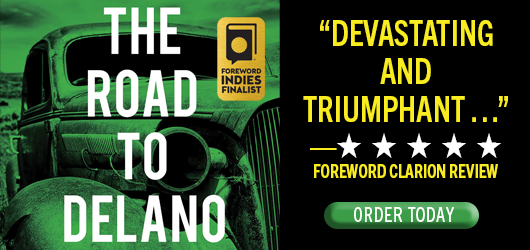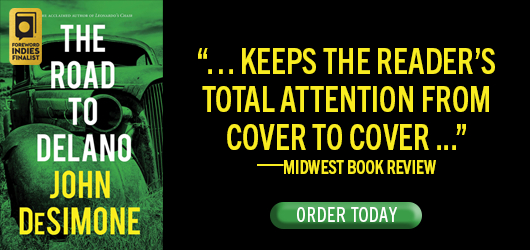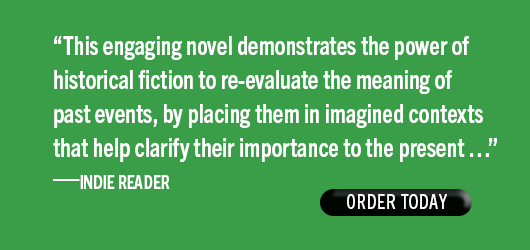Reviewer Michelle Anne Schingler Interviews John DeSimone, Author of The Road to Delano
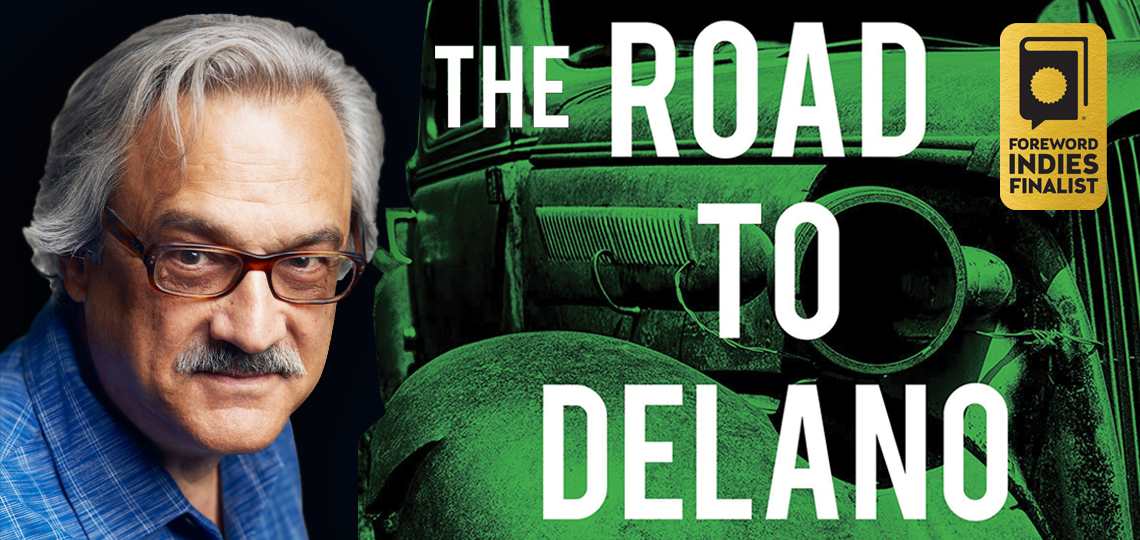
Amazon’s recent efforts to discourage warehouse workers from joining a union in Bessemer, Alabama, has sparked renewed interest in this country’s many battles between powerful corporations and their blue-collar workforce. Alas, with the way US labor laws are written, employers enjoy huge advantages—which explains the long decline in unionization since the glory days of the powerful United Auto Workers many decades ago.
With these thoughts in mind, we were excited to discover John DeSimone’s new novel about Cesar Chavez’s successful efforts to organize farmworkers in California’s Central Valley in the 1960s. In her five-star Clarion review, Michelle Anne Schingler calls The Road to Delano “a meticulous historical novel that honors the bravery and sacrifices of those who stand up to injustice, even at great peril to their own well being.”
Hoping to learn more about Chavez’s nonviolent tactics and the way the strike played out, we connected Michelle and John for the following conversation. Thanks to Rare Bird for bringing this important work to light.
Though his girlfriend is an activist and his best friend is the son of a UFW organizer, Jack does not begin the novel as a self-proclaimed ally to Cesar Chavez’s fight. Why was it initially so easy for him, and other Delano teenagers, to look away from the movement occurring around them?
The town was divided not just demographically, like most towns with wealthy and poor neighborhoods, but ethnically and most of all by employment. Farmworkers on one side of the tracks and the growers, their children, and all the business support apparatus of farming on the other side. The town was also divided in their views of the labor strike. There didn’t seem to be any middle ground in people’s attitudes. For fieldworkers to walk off the job threatened the economic life of the growers, their families, and the entire community because all jobs in the area either were in agriculture or supported it.
Traditionally, farmworkers migrated from field to field, following the ripening of the crops each season from south to north. So fieldworkers and their kids would move on after a few months. There were few relationships between them and the children of growers and businesspeople except as depicted in my novel in sports or other common activities. It was well accepted that the future leaders were the sons and daughters of the growers. They were expected to take leadership, excel in sports, and in the classroom etc., and go to college. While farmworkers and their family moved on to the next field.
Delano was a different situation than most of the small farming communities. A fair share of the farmworkers settled in the community because the grape fields, unlike the lettuce fields, needed tending all year around. Vines needed trimming, weeding, fertilizing, watering, and tending to make sure they thrived in the growing season. So a sizable community of farmworkers settled in and grew up around the city. This is why Cesar Chavez, in seeking to organize the farmworkers, settled his headquarters in Delano.
By the time the strike began in 1965, the sides were pretty hardened in their opinions of each other. The community consensus was that Cesar Chavez was a troublemaker, and dead wrong about the conditions of the farmworkers. The other accusation, much more damning and carried significant weight and was widely written and talked about by the growers and their sympathizers, was that Cesar Chavez was promoting a communist agenda. He planned to “collectivize” all agriculture in the US under his union and put his union under the authority of the Soviets. With that type of information in the back of their minds, kids carried this story to school with them. It was only natural there would be a deep distrust between the haves and have nots.
Jack, my main character, would have heard those stories. He may not have believed them, but he didn’t work in the fields, so he had no way of knowing the truth. He had no way of knowing how difficult and dirty and demeaning the work was, except through his own discoveries, and his relationship with his friend Adrian.
Your novel takes place mid-strikes, when Delano grapes are the bane of US housewives, and the growers are angry to the point of violence. What went into your decision to end the story before the UFW strike achieved its aims?
I had length in mind as well as dramatic action. I had seen the movie about Chavez and the strike that had come out a few years before—the one produced and directed by Diego Luna. While I thought it was good, it lacked the intensity, in my mind, of the actual events because it covered in two hours the action from his decisions in the fields of Oxnard in 1960 to the union’s victory in 1970. The director took a big bite out of a very complex story, where I wanted a more focused story. But it was well done and made its point. What dissatisfied me was that Chavez’s year of organizing in Oxnard where he discovered that a union would work, is so dramatic and pivotal to his future work, yet it was handled in one brief scene. I was disappointed in that, but I understood the issues the filmmaker was dealing with. Time and budgets. The other issue dealt with quickly in the movie, was his fast for nonviolence. By the time the movie released, I had already decided to make this event pivotal to my story. His fast for nonviolence was not only pivotal to the entire nonviolence campaign, but to me is one of the central tenants of his life-work. “No one can defeat nonviolence,” Chavez was fond of saying.
It was Chavez’s use of nonviolence that finally allowed the strike to continue as long as it did. In the past, the growers had successfully instigated a violent response from the strikers, triggering a response from the authorities who always took the side of the growers. By motivating his followers to practice nonviolence, Chavez forced the strike to a successful conclusion. A first in over a hundred years of labor chaos on the Central Valley. So I built the arc of my story around that event. I wanted my characters to react to Chavez’s call for nonviolence.
Essentially, The Road to Delano is a coming of age story for both Jack and Adrian, with the morality of the strike in the background.
I began school in California and finished it in the South; in both places, it felt as though the stories of 1960s nonviolent leaders were either whitewashed, as is the case with MLK Jr., or simply not spoken of (I learned about Chavez on my own, as an adult). But these are people who changed the world for the better, and too often at great personal cost. What can those with perhaps similarly paltry understandings of the Delano strikes, and of Cesar Chavez’s legacy, take away from your novel, and from Cesar Chavez’s activism, to continue effecting the change that he envisioned today?
That’s a big question: What will people take away from my book? What I hoped was a renewed appreciation for his courage to work on behalf of the poor. When I began researching Chavez and what went on around Delano during those years, I felt I was reading about a foreign country, maybe a third world country—not the United States. Certainly not California. But yes, this was the California of the times.
Many things impressed me about Cesar Chavez. But one decision stands out. He purposely chose to not move into the middle class, but took an unpopular stand to help poor farmworkers by identifying with them. This is where the image or theme of the “The Road” came from in the title and in the book. There are those who have heroic moments. They respond to an unusual occasion that arises by acting courageously. And we call them heroes, and rightly so. But what Cesar Chavez did was different. He was a gifted organizer and had an opportunity to move up into a different socio-economic group, and he chose not to. He walked in the shoes of the poor farmworker because he knew that life. He knew he could make a difference in their lives if he dedicated himself to that cause. He took the road that led him to Delano, both literally and figuratively. He chose to live a difficult life to benefit others.
He dedicated his life to the task of trying to make their lives, which were harsh in every sense of the word, better. Better for them, and better for their children. That defines heroic to me. He wasn’t the only hero in the movement—not by any means. So many others made huge sacrifices as well. But Cesar Chavez was the moral leader. And his encouragement of those who labored to harvest our food, that the work may be hard, but it is not insignificant. Just as their lives were not insignificant. All work has its value before God and society, and the worker is worthy of the dignity of a decent wage, decent working conditions, and to be treated humanely.
In my novel set during this critical moment, the characters are forced to ask themselves what path they are going to take. That to me is one of the takeaways of the book.
Additionally, the long-term effects in the landscape of the farmworkers in California has radically changed as the result of those pivotal years of the two strikes. The movement he started is still alive, and Chavez’s son, Paul, and the UFW leaders are very active in continuing to seek better lives for the essential workers who labor very hard to keep us fed. There are still wages, working conditions, and migration issues, but the bar of working conditions has been raised. The abuses of the past have mainly disappeared. Pesticide poisoning is still a reality in the valley. But the lives of so many hard-working farmworkers have been improved.
The lasting legacy is the Latino population is no longer marginalized in the area, but many have risen to leadership and ownership positions, just as Chavez predicted many years ago.
I’ve heard from so many readers that they had no idea Cesar Chavez did the things I wrote about. Readers are aware of his name and the grape strike, but the details of what he and others did are vague. I’m glad to book is introducing so many to Chavez’s life and work rooted in nonviolence as a tactic for change.
Your story also involves the fights over water rights that are a persistent topic in Central Valley politics. I won’t ask you to suggest a solution to those, because they are complicated, but do you have a sense that, if the state had been wiser in handling the topic in Sugar’s time, it might not be such a volatile one today? Or was this inevitable, given the state’s centrality to American foodways?
You hit on a sore topic for Californians in the Central Valley. No doubt that water rights could have been managed so much better. There is a constant tension between the needs of urban California vs. the needs of the farmers and orchardists. Throw in the environmental demands to preserve the fish in the state’s northern rivers and deltas, and you have a tug of war for water that is nearly intractable to solve. No one knows exactly how much the farmers use in a given year because some tap their own aquifers.
I used water rights in my story because it’s a constant concern of growers, and battles take place all the time on who gets first use of the rivers and streams.
Who was your inspiration for Sugar (alluded to in your acknowledgments), and how did their story build into yours?
In my research, I ran across a series of essays in a used bookstore. One of them was written by a man who tried to change the way the growers dealt with the migrant workers. He was a prominent grower at the time, and gave several speeches at the regular meetings about reforming the way farmworkers were treated. He ended up leaving the valley after several years of harassment by unknown assailants. His fields and equipment were damaged, and he received threatening phone calls at all hours. He sold his land and moved to Sacramento and took up a new job.
I used this real person as a model for Sugar. The gambling part is made up. I gave Sugar enough swagger to carry the story, and that’s why I think he lives on in the minds of readers. My editor at Rare Bird wanted me to continue to tell his story, even though he was dead. I took that as a compliment that he was well done, and readers wanted to know more about him. My wife to this day reminds me that I killed off two of the most likable characters and that I had to promise her I would not do that again. But what I found while writing this story is that I had to let the story unfold in certain ways even if at the moment it was unpleasant, if I wanted to arrive at a meaningful ending. And I do believe authors need to deliver an ending that fits the story.
Can you talk a bit about the Central Valley gambling halls that Sugar commands, and that Jack enters as a neophyte, in your novel? Were these real places? If so, what interesting stories did you uncover in researching them?
Ha! You caught me here, red-handed. I don’t know anything about them, except they existed from what I read. I made up all the halls, their names, the characters, and their exploits. On the other hand, I used a high school yearbook from Delano High School to figure out the teams and the various rivalries.
Some might be tempted to dismiss Ella and Jack’s organizing efforts as the work of idealistic teenagers, but I’m not so sure. When you envision your characters today—Ella and Jack, but also Adrian’s family, and even Darcy—what are they doing, worrying over, and standing for?
For the first part of the question, I don’t think it’s too idealistic to think some high school kids would be aware enough to understand the issues that divided their community. Granted some of the better off kids were focused on getting on with their lives, but others did stand up to speak out against the Vietnam war. On my high school campus in Southern California, the war, for or against, divided friendships. From what I learned, the strike divided the town, families, and friendships. Some students were more moved by the issue than others, granted.
As for what Jack, Ella, Darcy, and Adrian’s family are doing today. I’m writing that book right now. If the ’60s were stressful and dangerous for growers and farmworkers, the ’70s were violent and life-changing. All I can say is all of these characters are knee-deep in troubled waters.
Thank you for interviewing me and your interest in The Road to Delano. The story will always be the path Jack, Adrian, and Ella must take to find their strength, their duty, their destiny. I’m also very pleased that the Foreword awards panel selected The Road to Delano as 2020 INDIES Finalist for Historical Fiction.
The Road to Delano
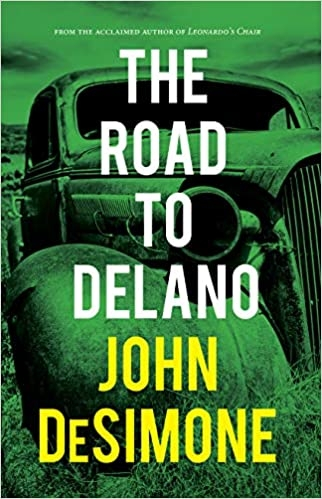
John DeSimone
Rare Bird
Hardcover $26.00 (428pp)
978-1-64428-031-7
Devastating and triumphant, The Road to Delano is a meticulous historical novel that honors the bravery and sacrifices of the UFW strikers and those who stood with them.
In John DeSimone’s gripping historical novel The Road to Delano, the UFW strikes, led by César Chavez, help to direct a high school senior’s coming of age.
Following the death of Jack’s father, he and his mother saw their once impressive farm reduced to a mere acre. Ten years later, from the windows of their Victorian home, they can still survey all of what used to be Duncan land, which now belongs to a calculating neighbor. With even this tentative homestead compromised by looming tax bills, Jack finds himself facing hard realities at too young of an age.
Even so: his troubles pale before those of his childhood best friend’s. Adrian’s father is helping to organize the strikes that have made Delano grapes the bane of housewives across America. Doing so puts him in the crosshairs of angry growers and the police forces sympathetic to them. Strikers are jailed and beaten; their children’s educations are threatened; some people are deported.
Jack and Adrian have a common enemy in the grower who bought the Duncans’ land out from beneath them, and who fired Adrian’s father for wanting to form a union. Defeating him requires all of their stealth, bravery, and ingenuity—and, in Jack’s case, the adoption of gambling. His father’s legacy precedes him in the Valley poker halls where his father once amassed a fortune. On the table: not only his family’s legacy, but his whole future, which depends on a baseball scholarship to UCLA, where he plans to study with Adrian and his firebrand girlfriend, Ella.
DeSimone’s novel captures its settings and period well. Tule fog obscures the rural road that Jack travels just before his constructed reality falls apart; the elder Duncans survey the fertile land before building their home, marveling in its potential. The California growing region’s beauty and centrality to American food chains is emphasized. Meanwhile, Valley citizens are depicted clashing not just over the strikes, but over local rivalries. On the baseball diamond, Adrian and Jack are challenged by added proof that so-called winners don’t always play fair. Over illicit games of Texas Hold ’Em, Jack learns the same about local card sharps, for whom racial tensions add layers of competition.
But as exciting as the book’s sports and gambling scenes are, the novel’s staying power comes through its depictions of the strikes themselves. César Chavez is among its cast—a brilliant, imposing, and principled figure who urges strikers and pickers not to meet violence with violence. His calm, even in the midst of a weeks-long fast, gives Jack and Adrian the boosts they need to persist through perilous challenges.
Devastating and triumphant, The Road to Delano is a meticulous historical novel that honors the bravery and sacrifices of those who stand up to injustice, even at great peril to their own well being.
MICHELLE ANNE SCHINGLER (February 7, 2021)
Michelle Anne Schingler

